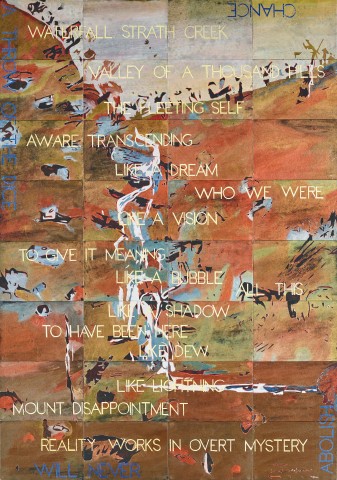WATERFALL VARIATION II, 2012
IMANTS TILLERS
synthetic polymer paint and gouache on 32 canvas boards
201.5 x 141.5 cm overall
each panel numbered sequentially with stencil verso: 091406 – 091437
Company collection, Melbourne, acquired from directly from the artist
The Fleeting Self, Arc One Gallery, Melbourne, 18 June – 20 July 2013
In 2014, Barry Pearce, emeritus curator of Australian art at the Art Gallery of New South Wales, selected one hundred paintings from its collection for his publication 100 Moments in Australian Painting, through which he traced the artworks instrumental in the formation of an enduring image of the Australian continent. Amongst these paintings was Eugene von Guérard’s 1862 masterpiece, Waterfall, Strath Creek. Although modest in scale, it encapsulated the Romantic sense of awe and scientific exactitude that propelled the Austrian artist to the status of one of Australia’s greatest colonial painters. Waterfall, Strath Creek became a touchstone of Australian landscape painting for contemporary artists during the 1970s and 1980s, its dynamic composition reprised several times in a chain of appropriation that culminated with Imants Tillers’ Wynne prize-winning painting, Waterfall (After Williams), 2011 and associated major works based on this theme, including Waterfall Variation I and Waterfall Variation II.
Tillers explained that these paintings could be more aptly described as ‘meditations on landscape’ in the wake of the revolution of Aboriginal landscape painting.1 As it was for von Guérard, the physical landscape is for Tillers a stimulus for Kantian self-reflection, a subjective assessment of man’s place in the environment, although this is conveyed without the colonial artist’s diminutive Rückenfigur explorers in the foreground. Key to Tillers’ work is the idea that the landscape is a constructed space, the product of a highly mediated conception of nature. A postmodern artist par excellence, Tillers’ longstanding artistic practice has been founded on its devices: appropriation, grid-based enlargement and reproduction and application of text and stencilled overlay on the painted surface.
The subject of Waterfall Variation II is in fact, thrice removed from the original subject, a 50 metre valley through which flows the Strath Creek waterfall, in the thickly timbered country of Victoria’s Mount Disappointment. Von Guérard visited this site in January of 1862, as did Fred Williams in 1970 when he painted Free copy of Eugene Von Guerard’s Waterfall Strath Creek, now held in the National Gallery of Australia.2 Tillers did not go so far, choosing instead to appropriate Fred Williams’ gouache plein-air study, translating its painterly gestures into graphic, stencilled silhouette in a mosaic over thirty-two separate canvas boards. Further obscured under layers of text, the final image of Waterfall Variation II bears little resemblance to von Guérard’s original detailed naturalist painting.
Physically, Strath Creek Falls has borne many climactic and environmental changes, from extensive timber logging in the 1880s, to the decades-long droughts and cataclysmic bushfires of more recent memory. We are clearly yet to master this unknown landscape. Over a hundred years after von Guérard, contemporary artist William Delafield Cook sat at the same spot in the bottom of the valley, looking up towards its V-shaped ravine. Having admired von Guérard’s topographical accuracy, he set out to record the scene with his own signature photographic realism. The resulting vast painting of a parched and bleached summer landscape won the Wynne prize in 1980 and was acquired for the Art Gallery of New South Wales’ collection the following year.3
As an interpretation of an interpretation, Tillers’ work speaks to the idea of flux and transience, with the waterfall a metaphor for an everchanging landscape. Its spectacular scale provided a perfect template to illustrate the grand theatre of nature and our attempts to dominate it, becoming for Tillers an archetypal image through which to illustrate the changing attitudes towards landscape painting in Australia.
1. The artist, 9 April 2012 [https://www.artgallery.nsw.gov.au/prizes/wynne/2012/29209/]
2. Fred Williams, Untitled, [Free copy of Eugene Von Guerard's Waterfall, Strath Creek, 1862], 1970, gouache, 60.2 x 79.4 cm (sheet), in the collection of the National Gallery of Australia, Canberra
3. William Delafield Cook, A waterfall (Strath Creek), 1980 – 1, synthetic polymer paint on canvas, 198.2 x 156.2 cm, in the collection of the Art Gallery of New South Wales, Sydney
LUCIE REEVES-SMITH
